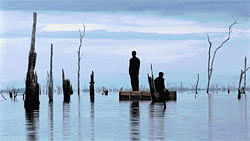Powerful and disquieting

In the best of minimalist tradition, Charly Nijensohn’s videos are of very short duration: not a single word is spoken in them; not a clear human face seen; no explanation given; no (digital or other) manipulation resorted to. Yet they create disquieting moods and powerful narratives about man’s insatiable greed and the alarming degradation of
nature.
The 44-year old Berlin-based filmmaker who was born in Buenos Aires, Argentina says that the scope of his work is based on a cosmological and existential approach. In order to capture the tensions derived from the relationship between humans and their environment, he chooses to look for the most desolate and remote landscapes, ‘hoping to find a poetical metaphysical answer to my own existence.’
Dead Forest Storm (2009/ 4 min 48 sec /Argentina/Brasil) and El naufragio de los hombres (The Wreck of Men /2008/7 min 28 sec) are two fine examples of Nijensohn’s evocative works.
In Dead Forest Storm, the eerie silence enveloping the frames and unidentified men standing on wobbly supports on an all-pervading waterfront become part of a gripping if tragic drama with the dim and dusky visual tones highlighting the anxiety in the relationship between man and nature.
The backdrop for the film is the construction of the Balbina Hydroelectric Dam and power station on the Uatumã River in the Amazon Rainforest. The large scale project from 1985 to 1989 in Amazonian Brazil was undertaken to provide electricity supply to Manaus, a populous city and capital of Amazonas state. The result of the development was devastating. It created the biggest artificial lake in Latin America and, flooded a substantial part of the Amazonian forest. As dreadfully, the controversial project uprooted the tribes Waimiri and Atroari from their ancestral home grounds.
“Dead Forest Storm extends projections on different metaphoric levels,” observes Argentinean art critic Rodrigo Alonso. “The omnipresence of water, attacking and at the same time supporting the central character, forms a fluid, liquid universe in which we can perceive another representation of contemporary life.
However, the metaphor that is highlighted with greatest intensity is that of resistance, a recurring image in Nijensohn’s work which takes on eloquent political connotations in the context of Argentina, where to a certain degree it can be translated into the artist’s very existence in an environment that is hostile for non-commercial production, and from which he eventually had to emigrate.
It is only from this perspective that it is possible to comprehend Nijensohn’s work in all its magnitude. Although the characters in his videos are always alone, society is there as a horizon and persistence is a principle of hope that expands outward by way of vibrations that the work incites in the heart of each and every viewer.”
El naufragio de los hombres is another haunting piece incorporating a series of photographs and videos made in Salar de Uyuni, Bolivia, and capturing the surreal landscape of the largest salt flat in the world during the rainy season when the land is flooded. The backdrop of the film is the native communities of Bolivia being in a state of emergency, and how extreme poverty threatens to destroy their cultural heritage.
“In El naufragio de los hombres, humans lost in the immensity of the horizon and enduring the inclemency of nature are an image of the confrontation between human fate and an indifferent universe,” explains Nijensohn. “Exposed to the erosion of time, they vanish into the emptiness. In silence and isolation, they are testimony of an existence which, in disappearing, becomes a declaration of principles.”
Dead Forest Storm and El naufragio de los hombres are grim but lyrical films which eloquently comment on the tragic loss of indispensable natural resources. They are among Nijensohn’s several works exhibited in prestigious forums like Biennale of Venice 2003 (Italy), ARCO (Spain), Armory Show (USA), and Interferences (France).
Nijensohn’s videos are currently being shown in Bangalore. They are part of the exhibition Cinema Verite Redux, put together by Berlin-based writer and curator, Shaheen Merali. Besides Nijensohn, the show features six other artists: Subba Ghosh with his two hyper-real, cut out images of security guards; Ravi Kumar Kashi, presenting a set of photographs of a squatting Gandhi figurine (bought from chor bazaar for ten rupees!) inside a hall of mirrors; Attila Richard Lukacs (b. 1962, Calgary, Canada) whose intense portraits are painted on wood panels sourced from rubbish bins in New York, Mount Abu and demolition sites in Vancouver; Parvathi Nayar with a series of intricate graphite drawings which attempt to subtly investigate constructs of gender and relationships; Prasad Raghavan with his series of ten meticulously designed photo-collages; and Marina Roy (b. 1966 / Quebec, Canada) with her fascinating Apartment, a 56-minute animation with 100 vignettes inspired by French novelist and filmmaker Georges Perec’s novel La Vie mode d'emploi (1978).
In his curatorial note, Merali explains that the exhibition has proposed a space filled with differing rhythms that have emerged out of each artist’s particular understanding of the world and their aspirations concerning certain issues. He feels that the artists – as constant explorers of the social, cultural and physical dimensions of the city, and its effects on the wider terrain – have helped understanding of our global contemporaneity which has resulted in gross degeneration from the application of rules.
“The artists’ cursory glances at the alarming rate of diminishing returns and entropy offers a new basis of looking at the structured relationships between time and place, private and public, framework and discordant content,” says Merali. “It creates a temporal look at urban space and the human condition within the uncertainty that we are learning to call ‘the fallen earth’.”
Cinema Verite Redux continues at Gallery Sumukha, Bangalore till July 30.